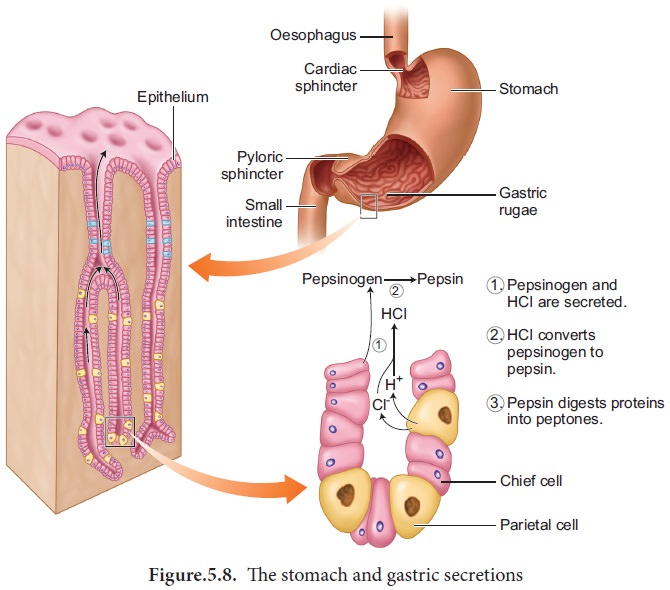buccal cavity, stomach, small intestine - Digestion of food and role of digestive enzymes | 11th Zoology : Chapter 5 : Digestion and Absorption
Chapter: 11th Zoology : Chapter 5 : Digestion and Absorption
Digestion of food and role of digestive enzymes
Digestion of food and role of
digestive enzymes
The
process of digestion converts the solid- food into absorbable and assimilable
forms. This is accomplished by mechanical and chemical processes.
Digestion in the buccal cavity
The
smell, sight and taste as well as the -mechanical stimulation of food in the
mouth, triggers a reflex action which -results in the secretion of saliva. The
-mechanical digestion starts in the mouth by grinding and chewing of food. It
is called mastication. The saliva contain water, electrolytes (Na+,
K+, Cl–, HCC3), salivary amylase (ptyalin),
antibacterial agent lysozyme and a lubricating agent mucus (a glycoprotein).
The mucus in saliva prepares the food for swallowing by
moistening, softening, lubricating and adhering the masticated food into a
bolus. About 30 percent of polysaccharide, starch is hydrolyzed by the salivary
amylase enzyme into disaccharides (maltose). The bolus is then passed into the pharynx and then into the oesophagus
by swallowing or deglutition. The
bolus -further passes down through the oesophagus to the stomach by successive waves of muscular
contraction called peristalsis. The gastro oesphageal sphincter controls the
passage of food into the stomach.
Digestion in the stomach
Food remains in the stomach for 4 to 5 hours, the rhythmic peristaltic movement churns and mixes the food with gastric juice and make it into a creamy liquid called chyme. The gastric secretion is partly controlled by autonomic reflexes. The secretion of gastric juice begins when the food is in the mouth. The -gastric juice contains HCl and proenzymes. The proenzyme pepsinogen, on exposure to HCl gets converted into the active enzyme pepsin which converts proteins into -proteoses and peptones (peptides). The HCl provides an acidic medium (pH1.8) which is optimum for pepsin, kills bacteria and other harmful organisms and avoids putrifaction. The mucus and bicarbonates present in the gastric juice play an important role in lubrication and protection of the mucosal epithelium from the eroding nature of the highly acidic HCl (Figure. 5.8). Another proteolytic enzyme found in gastric juice of infants is rennin helps in the digestion of milk protein, caseinogen to casein in the presence of calcium ions. This enzyme-secretion gradually reduces with aging.

Digestion in the small intestine
The bile,
pancreatic juice and intestinal juice are the secretions released into the
small intestine. Movements generated by the muscularis layer of the small
intestine helps in the thorough mixing of the food with various secretions in
the intestine and thereby facilitate digestion.
The
pancreatic juice contains enzymes such as trypsinogen, chymotrypsinogen,
carboxypeptidases, pancreatic amalyses, pancreatic lipases and nucleases.
-Trypsinogen is activated by an enzyme, enterokinase, secreted by the
intestinal mucosa into active trypsin, which in turn activates the enzyme
chymotrypsinogen in the pancreatic juice. The bile contains bile pigments
(bilirubin and biliverdin) as the break down products of haemoglobin of dead
RBCs, bile salts, cholesterol and phospholipids but has no enzymes. Bile helps
in emulsification of fats. Bile salts reduce the surface
tension of fat droplets and break them into small globules. Bile also activates
lipases to digest lipids.
Proteins
and partially digested proteins in the chyme on reaching the intestine are
acted upon by the proteolytic enzymes of pancreatic juice. Trypsin hydrolyses
proteins into polypeptides and peptones, while chymotrypsin hydrolyses peptide
bonds associated with specific amino acids.
The
pancreatic amylase converts glycogen and starch into maltose. Lipase acts on
emulsified fat (triglycerides) and hydrolyses them into free fatty acid and
monoglycerides. Monoglycerides are further hydrolysed to fatty acid and
glycerol. Nucleases in the pancreatic juice break the nucleic acid into
nucleotides and nucleosides.
The secretions of the Brunner's gland along with the secretions of the intestinal glands constitute the intestinal juice or succus entericus. The enzymes in the intestinal juice such as maltase, lactase, sucrase (invertase), dipeptidases, lipases, nucleosidases act on the breakdown products of bile and pancreatic digestion.

The mucus along with the bicarbonate ions from the pancreas provides an alkaline medium (pH 7.8) for the enzymatic action. As a result of digestion, all macromolecules of food are converted into their corresponding monomeric units.

The
simple substances thus formed are absorbed in the jejunum and ileum region of
the small intestine. The undigested and unabsorbed substances are propelled
into the large intestine. The activities of the gastro-intestinal tract are
carried out by the neural and hormonal control for proper coordination of
different parts. Gastric and intestinal secretions- are
stimulated by neural signals. Hormonal control of the secretion of -digestive
juices is carried out by local hormones produced by the gastric and intestinal
mucosa.
Related Topics